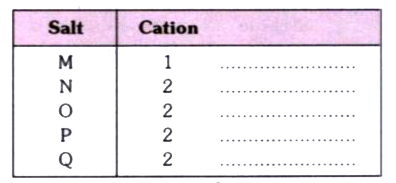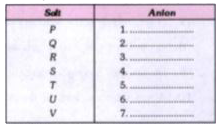A chloride which forms a precipitate that is soluble in excess of ammonium hydroxide is :
Calcium chloride
Ferrous chloride
Ferric chloride
Copper chloride
The correct Answer is:D
To solve the question "A chloride which forms a precipitate that is soluble in excess of ammonium hydroxide is:", we can follow these steps:
Step 1: Understand the Question
We need to identify a chloride compound that forms a precipitate when reacted with ammonium hydroxide (NH4OH) and that this precipitate is soluble in excess ammonium hydroxide.
Step 2: Identify Common Chlorides
Common chlorides include:
- Ferrous chloride (FeCl2)
- Ferric chloride (FeCl3)
- Copper(II) chloride (CuCl2)
- Calcium chloride (CaCl2)
Step 3: React Each Chloride with Ammonium Hydroxide
1. Ferrous Chloride (FeCl2):
- When FeCl2 reacts with NH4OH, it forms ferrous hydroxide (Fe(OH)2) as a precipitate.
- Fe(OH)2 is not soluble in excess NH4OH.
2. Ferric Chloride (FeCl3):
- When FeCl3 reacts with NH4OH, it forms ferric hydroxide (Fe(OH)3) as a precipitate.
- Fe(OH)3 is also not soluble in excess NH4OH.
3. Copper(II) Chloride (CuCl2):
- When CuCl2 reacts with NH4OH, it forms copper(II) hydroxide (Cu(OH)2) as a precipitate.
- Cu(OH)2 is initially insoluble, but when excess NH4OH is added, it forms a soluble complex, tetraamminecopper(II) chloride ((Cu(NH3)4)Cl2).
4. Calcium Chloride (CaCl2):
- When CaCl2 reacts with NH4OH, it forms calcium hydroxide (Ca(OH)2).
- Ca(OH)2 is not soluble in excess NH4OH.
Step 4: Conclusion
From the analysis, the only chloride that forms a precipitate which is soluble in excess of ammonium hydroxide is Copper(II) Chloride (CuCl2).
Final Answer
The chloride which forms a precipitate that is soluble in excess of ammonium hydroxide is Copper(II) Chloride (CuCl2).
---
We need to identify a chloride compound that forms a precipitate when reacted with ammonium hydroxide (NH4OH) and that this precipitate is soluble in excess ammonium hydroxide.
Common chlorides include:
- Ferrous chloride (FeCl2)
- Ferric chloride (FeCl3)
- Copper(II) chloride (CuCl2)
- Calcium chloride (CaCl2)
1. Ferrous Chloride (FeCl2):
- When FeCl2 reacts with NH4OH, it forms ferrous hydroxide (Fe(OH)2) as a precipitate.
- Fe(OH)2 is not soluble in excess NH4OH.
- When FeCl3 reacts with NH4OH, it forms ferric hydroxide (Fe(OH)3) as a precipitate.
- Fe(OH)3 is also not soluble in excess NH4OH.
- When CuCl2 reacts with NH4OH, it forms copper(II) hydroxide (Cu(OH)2) as a precipitate.
- Cu(OH)2 is initially insoluble, but when excess NH4OH is added, it forms a soluble complex, tetraamminecopper(II) chloride ((Cu(NH3)4)Cl2).
- When CaCl2 reacts with NH4OH, it forms calcium hydroxide (Ca(OH)2).
- Ca(OH)2 is not soluble in excess NH4OH.
From the analysis, the only chloride that forms a precipitate which is soluble in excess of ammonium hydroxide is Copper(II) Chloride (CuCl2).
The chloride which forms a precipitate that is soluble in excess of ammonium hydroxide is Copper(II) Chloride (CuCl2).
Topper's Solved these Questions
Similar Questions
Name a hydroxide which is soluble in excess of ammonium hydroxide.
View SolutionName :
a hydroxide which is soluble in excess of ammonium hydroxide.View SolutionIdentify the acid which matches the following description
The acid on mixing with silver nitrate solution produces a white precipitate which is soluble in excess ammonium hydroxide.View SolutionIdentify the acid which matches the following description (i) to (v):
The acid on mixing with silver nitrate solution produces a white precipitate which is soluble in excess ammonium hydroxide.View SolutionIdentify the anion present in the following compound : When a solution of compound Y is treated with silver nitrate solution a white precipitate is obtained which is soluble in excess of ammonium hydroxide solution.
View SolutionSalts M, N, O, P and Q undergo reactiom (i) to (v) respectively.
Identify the cation present in these salts on the basis of these reaction. Tabulate your answer in the format given below.
1. When sodium hydroxide solution is added to the salt M, and heated strongly a colourless gas with a pungent smell is evolved which turm red litmus paper blue and gives dense white fumes with a moist glass rod with hydrochloric acid.
2. Addition of dilute hydrochloric acid to a solution of N gives a thick white precipitate which is soluble in hot water.
3. When ammonium hydroxide solution is added to the solution of 0 a light blue precipitate is obtained which is soluble in excess of ammonium hydroxide to form an inteme deep blue solution.
4. When ammonium hydroxide solution is added to the solution of P reddish brown (mustard colour) precipitate is obtained which ,is insoluble even in the excess of ammonium hydroxide solution.
5. When sodium hydroxide solution is added to the solution of Q a which coloured gelatinous precipitate is obtained which is soluble in excess of sodium hydroxide to form a clear solution
 View Solution
View SolutionBurning magnesium ribbon is taken in gas P when it form a salt R. The salt R dissolves in water and gives curdy white precipitate with silver nitrate solution. This precipitate is soluble in excess of ammonium hydroxide solution. Name the gas P and salt R. State the chemical reaction between P and magnesium
View SolutionSalts P, Q,R,S,T,U and V undergo reactions (i) to (vii) respectively. Identify the cation present in these salts on the basis of these reactions. Tabulate your answer in the formate given below.
(i) When the salt Pis heated with sodium hydroxide solution a vigorous reaction takes place and a colourless gas is evolved with a pungent and suffocating smell that brings tears in our eyes. The evolved gas gives dense white fumes with a moist glass rod depped with hydrochloric acid.
(ii) Addition of sodium hydroxide solution to a solution of salt Q gives a thick white precipitae which is soluble in excess of sodium hydroxide solution to form a clear solution.
(iii) Addition of ammonium hydroxide solution to a solution of salt R gives a dark blue precipitate which is soluble is excess of ammonium hydroxide solution to form an intense deep blue solution.
(iv) Addition of ammonium hydroxide solution to a solution of 5 gives a dirty green [bottle green] precipitate which is insoluble even in the excess of ammonium hydroxide solution.
(v) Addition of ammonium hydroxide solution to a solution of T gives a reddish brown (rust precipitate] precipitate which is insoluble even in the excess of ammonium hydroxide solution.
(vi) Addition of ammonium hydroxide solution to a solution of V gives a geletaneous white precipitate which is soluble in excess of ammonium hydroxide solution to form a clear solution.
(vii) Addition of ammonium hydroxide solution to a solution of V gives no precipitate but it gives a chalky white precipitate with sodium hydroxide solution which is insoluble even in the excess of sodium hydroxide solution.
 View Solution
View SolutionIdentify the cation (positive ion) and anion (negative ion) in - 'A','B' & 'C'. Also identify P, Q, R, S, T, U, V, W.
a] Substance 'A' is water soluble and gives a curdy white precipitate 'P' with silver nitrate solution. 'P' is soluble in ammonium hydroxide but insoluble in dil. HNO3 . Substance 'A' reacts with ammonium hydroxide solution to give a white precipitate ' soluble in excess of NH4OH.
b] A solution of substance 'B' is added to barium chloride solution. A white ppt. 'R' is formed, insoluble in dil. HCl or HNO3 . A dirty green ppt. 'S' is formed on addition of ammonium hydroxide to a solution of 'B' and the precipitate is insoluble in excess of ammonium hydroxide.
c] Substance 'C' is a coloured, crystalline salt which on heating decomposes leaving a black residue 'T'. On addition of copper turnings and conc. H2SO4 to 'C' a coloured acidic gas 'U' is evolved on heating. A solution of'C' is added to NaOH soln. until in excess. A pale blue ppt. 'P' is obtained insoluble in excess of NaOH A solution of 'C' is then added to NH4OH soln. in excess to give an inky blue solution 'V'. A solution of 'C' is warmed and hydrogen sulphide gas is passed through it. A black ppt. 'W' appears.View SolutionA black solid P dissolves in warm and dilute HCI to form greenish yellow solution Q, but does not give off any gas. The solution Q on treating with ammonium hydroxide forms bluish white precipitates of R. The precipitates of R dissolve in excess of ammonium hydroxide. solution to form deep-blue colouration. Identify solid P and bluish white precipitates of R.
Write equations for action of excess of ammonium hydroxide on R.View Solution

